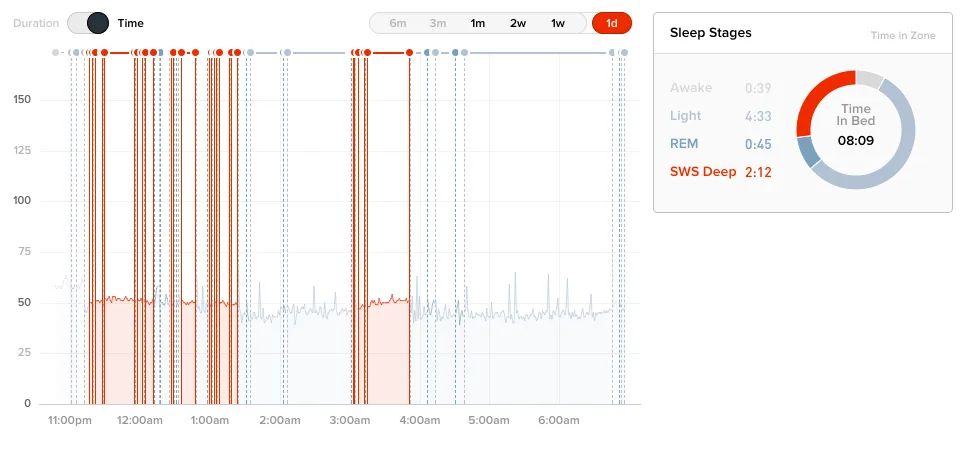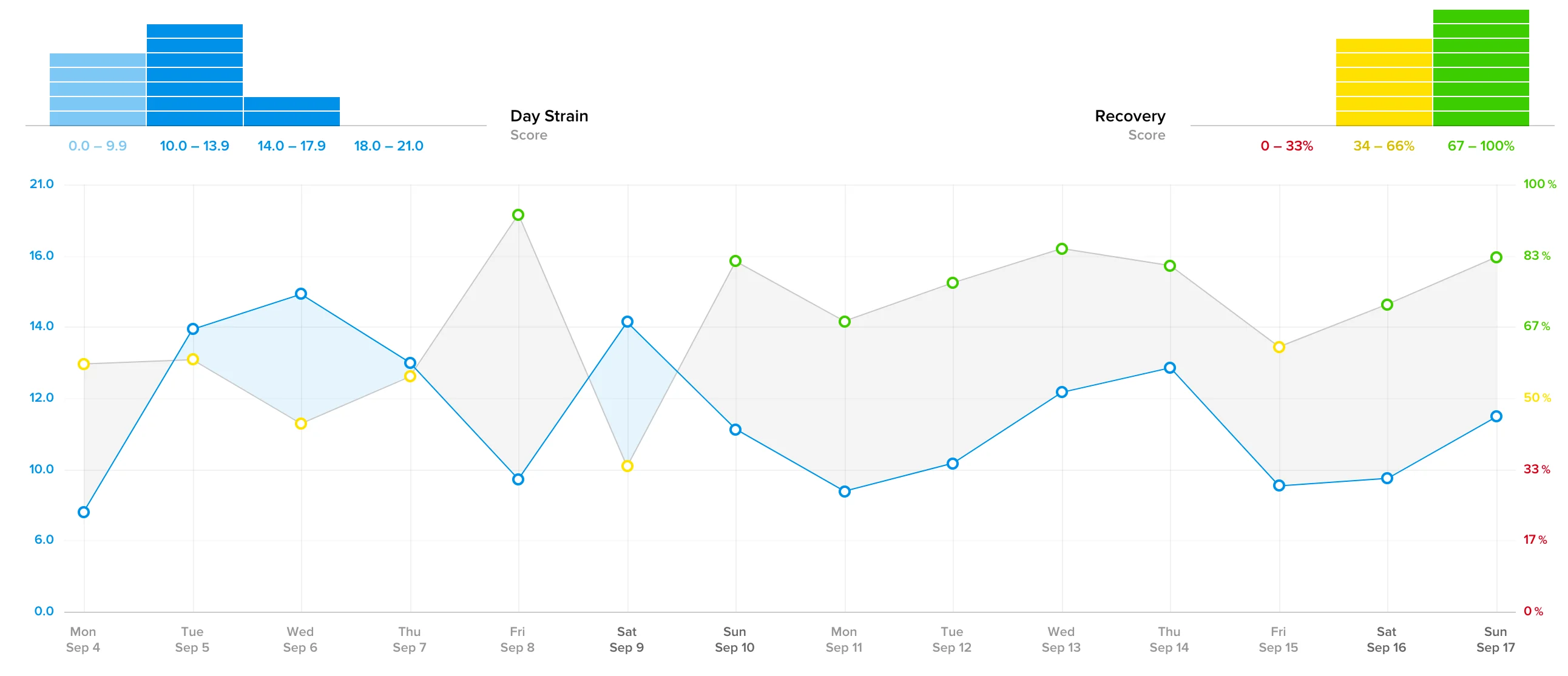Topics
- Article
Scott Stallings Talks WHOOP, his Career and Life on the PGA Tour

Pro golfer Scott Stallings opens up about battling chronic fatigue, his PGA Tour suspension, and how he’s reaching new heights by optimizing performance with WHOOP.
Originally from Worcester, Massachusetts, Scott Stallings’ first love was baseball. When told that WHOOP headquarters is across the street from Boston’s iconic Fenway Park, Stallings said, “You know, if I could play for the Red Sox one game a month, not even the whole game, just a few innings, I’d do it and quit golf altogether.” As a child, Stallings played many sports, but baseball was what he was best at. He still remembers the exact day when he decided to give it up and focus on golf: “It was the last week of March in 1997, the day before my 12th birthday. I was on a competitive team that played 60 games a year, an enormous time commitment. We were getting ready to start back up for spring practice when I made my first hole in one on the golf course. Two weeks later, Tiger Woods won the Masters by 12 strokes. I decided ‘I want to do that." The very next day I quit baseball. I called my coach and said ‘Hey, I’m going to go play golf, I want to do what Tiger does.’ They all thought I was nuts. Looking back on it, I probably was. I don’t know what I was thinking. But I fell in love with golf and wanted to do it for a living. I decided to chase it as a career and I’ve been very fortunate to be able to do it for a long time now.”
Missing the PGA Tour by 1 Stroke
In 2009, a 24-year-old Stallings fell a single stroke shy of qualifying for the PGA Tour. “In the moment, you think it’s the worst thing that’s ever happened to you,” he said. “But knowing what I’ve gone through now, it was actually the best thing that could’ve happened to me at the time. I definitely wasn’t ready. When you go to the tour, you want to go there and stay there.” Instead, Stallings played on the Nationwide Tour (now called the Web.com Tour), which he likened to Triple-A baseball. “It was a great experience for me,” he explained. “It helped me learn how to travel. I missed my PGA Tour card by a shot and two months later I’m flying to Australia and New Zealand to play in these Web.com tournaments. I was like, ‘Holy cow, I’m not ready for this either.’ The only way to get good at it is to do it. You have to learn your tendencies and what’s optimal for you." Stalling’s landed on the PGA Tour the following season
Getting on WHOOP
The travel, he says, is the most difficult aspect of being a pro golfer. It was also Scott’s impetus for using WHOOP: “I’m on the road 250 days a year, crossing time zones every week. At one point this summer I had a seven-week stretch where I was travelling for 51 days straight. That was when I knew I needed to do something. In particular, I needed to figure out what I’m doing when I’m sleeping. I want to train at a high level, I want to perform at a high level, but there’s a missing link here. Some days I feel like I could run through a wall, and some days I feel like the wall is going to run me over. That’s when I decided to try WHOOP.” At 32 years old, Stallings wasn’t in danger of losing his tour card, but he felt his career was stagnating. “I got my Strap on the Monday before the John Deere Classic,” he said. “I wore it the whole week, training every day in 90-degree heat. Then I finished 5th. The next week, in Alabama [at the Barbasol Championship], it was 100 degrees every day. I trained daily, slept great, and finished 3rd. Right from the start, I realized WHOOP is an unbelievable tool to evaluate your process to be ready to go each day.”
This shot was a lot of fun. Thanks to everyone for a great week at the @JDCLASSIC. pic.twitter.com/Y0MFxkq5aP — Scott Stallings (@stallingsgolf) July 16, 2017
Training Philosophy
“Get after it,” was Scott’s simple response when the topic of strength training came up. “I do it all. If I’m going to ask my body week in and week out to do a bunch of repetitive motion, I need to build a strong foundation to be able to push myself. My job has given me the chance to meet a lot of different people in golf, fitness and training. I’ve picked up pieces from everywhere. I would definitely say my training style does not fit your prototypical golfer.” “I’m way more geared towards high-intensity stuff, I’m not scared to lift a barbell or move around weight. I went to college with Rich Froning, he’s been a big influence on me, as well as a bunch of other guys in the CrossFit community.” Stallings’ trainer, Adam Kerley, chimed in on how they use WHOOP to guide Scott’s workout regimen: “It gives us actionable and objective information that enhances our ability to make wise decisions, particularly when it comes to the amount of Strain Scott takes on. We’re constantly striving to improve. The daily feedback from WHOOP deepens our accountability checks and helps optimize the direction of our training.”
Home vs. Road
“WHOOP has helped me a ton with training in regards to travel, especially in terms of how quickly I can bounce back,” Stallings told us. “I’m blown away by the trend analysis, I can tell the difference from when I’m home or on the road. I actually don’t do the things to recover as well when I’m at home. [Editor’s note: We heard the same thing from a commercial airline pilot]. For example, on the road I’ll have a shake or something to eat immediately after training. But at home, other things get in the way–my two kids, the house, etc. My diet and recovery are not always the top priority at home. I also approach my training differently when I’m traveling because I know I have to be ready for Sunday. I’ll start ‘greening it out’ everyday prior to tournaments.” Here’s a snapshot of Scott’s Strain (blue) and Recovery (green/yellow) heading into last month’s Wyndham Championship, which began on August 17:

“Well you’re not going to die, but you’ve got some problems that need to be fixed.”
There was a time not that long ago when Stallings thought his career might be over. “I had some pretty significant health stuff a few years back,” he said. “Major adrenal failure, I was a mess. I felt like I was doing all the right things, but I couldn’t figure out what was going on. I was gaining weight, sleeping all the time–I would wake up and literally not remember a single thing I did the day before. It sucked.” After numerous doctors and a constant struggle searching for answers, Stallings finally caught a break: “I found this doctor at UCLA and spent eight straight hours with him, he told me we were going to figure it out by the end of the day. Afterwards he said ‘Well you’re not going to die, but you’ve got some problems that need to be fixed.’ He called it a bunch of compounding negatives, something significant in my diet for the last 18-24 months. We found out that I was allergic to milk, sweet potatoes and barley. Amazingly, a protein shake I was drinking had all three. It was basically killing me and I drank it every day for two years. When my body was totally depleted from working out, what I was putting in it afterwards turned out to be the worst possible thing. It was crushing me.” Stallings says he and his wife laugh about it now, but at the time he was so wiped out that he regularly spent as much time in bed as their young son. “I’d sleep all night, wake up, take a nap, take another nap, have dinner and go to bed. It was awful, I wouldn’t wish that on anybody. I also found out that I had an obstructive sleep apnea from breaking my nose as a kid. I had surgery that basically rotorootered my sinuses. Before the surgery, I’d had two sleep studies done and had less than 15 minutes of total REM sleep over two nights. I never even got to deep sleep.” On the day we spoke to him, Stallings noted that WHOOP showed he’d gotten two hours and twelve minutes of deep sleep the night before. “I love seeing that,” he said

Sleep and Recovery Tip
At WHOOP, we’re always looking for ways to help our athletes maximize their Recoveries. “I like to take really cold showers before I go to bed,” Scott told us. “I’m a bigger guy, and I can’t stand to be hot when I go to sleep. I’ll get in the shower and stand under the freezing cold water for two minutes, dry off, throw some clothes on and jump right into bed. That definitely helps my Sleep and Recovery. Along those lines, I’m a big fan of cryotherapy as well.”
Pro-Golfer Scott Stallings is on the #PGA Tour & is using #cryotherapy to train harder & recover faster! #PGAProChamp #PGAChamp #pgatour pic.twitter.com/sLKtRjehLR
— Ice Up Cryo (@IceUpCryo) June 22, 2017
Suspension from the Tour in 2015
In February of 2015, Stallings was suspended from the PGA Tour for three months for using a banned substance. He’d been taking small doses of an over-the-counter hormone recommended by a doctor to combat his extreme fatigue. The Tour only found out because Scott brought it to their attention: “Anyone that knows me, especially in that instance, knows that there was never any ill-intent. I never failed any tests or anything, I actually went to the tour myself because I was trying to understand. I told them ‘I see this is on the banned list, but it’s what my doctor told me to take and I bought it at a grocery store. I’ve passed tests twice while taking it, what’s the deal?’ Then I found out that in order to actually fail with what I’d taken I needed to ingest 2,500 mg a day for three months. I only took 25 mg for 30 days. It never would’ve shown up anywhere.” Does Stallings regret coming forward in the first place? “Obviously I wish I hadn’t gone through all that publicly,” he said. “As a professional athlete, you kind of circumvent your right to being a normal human being. No one wants their health stuff out there, but it brought to light that the policy has holes that need to be fixed. If the same thing never happens to anyone else because of this, than that’s great. And at the end of the day, three months off was probably a good thing for me. So many guys have also reached out to me to say “What should I do? Help me not have what happened to you happen to me.” I’ve built lots of relationships from it and hopefully it will pave the way to get more people educated.”
2018 and Beyond
With his 2017 tournament schedule now in the books, Stallings is looking ahead to next year. The first event of the PGA Tour’s 2018 season kicks off October 5 in Napa, California. During his brief “offseason,” Scott is doing an outstanding job maintaining consistent levels of Strain and Recovery:

“It’s all a huge part of my fitness journey,” he elaborated. “By no means do I feel I have it all figured out, but I’m a hell of a lot closer now than I was. So many people take their health for granted. You only get one body, you can’t trade it in. The better we steward it and take care of it and educate ourselves on how to improve, the better we’ll be at everything we do.” For Scott, WHOOP has become a key piece of the puzzle.